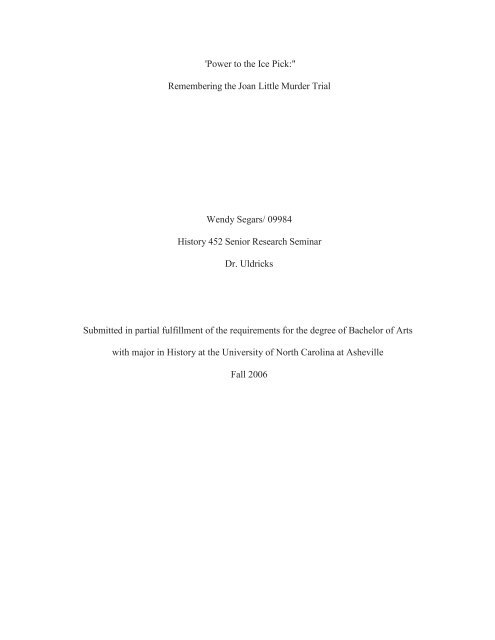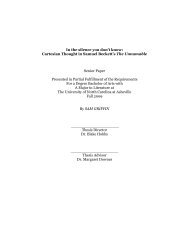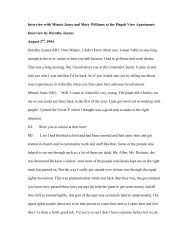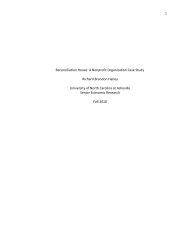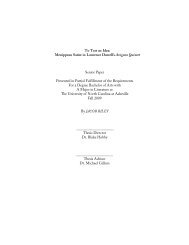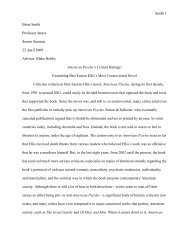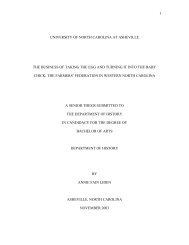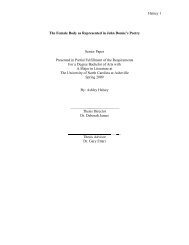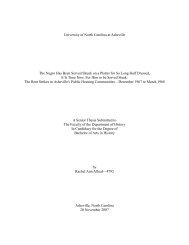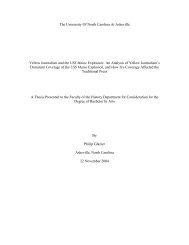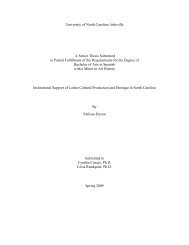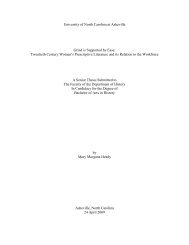'Power to the Ice Pick:" Remembering the Joan Little Murder Trial ...
'Power to the Ice Pick:" Remembering the Joan Little Murder Trial ...
'Power to the Ice Pick:" Remembering the Joan Little Murder Trial ...
Create successful ePaper yourself
Turn your PDF publications into a flip-book with our unique Google optimized e-Paper software.
<strong>'Power</strong> <strong>to</strong> <strong>the</strong> <strong>Ice</strong> <strong>Pick</strong>:"<br />
<strong>Remembering</strong> <strong>the</strong> <strong>Joan</strong> <strong>Little</strong> <strong>Murder</strong> <strong>Trial</strong><br />
Wendy Segars/ 09984<br />
His<strong>to</strong>ry 452 Senior Research Seminar<br />
Dr. Uldricks<br />
Submitted in partial fulfillment of <strong>the</strong> requirements for <strong>the</strong> degree of Bachelor of Arts<br />
with major in His<strong>to</strong>ry at <strong>the</strong> University of North Carolina at Asheville<br />
Fall 2006
"Power <strong>to</strong> <strong>the</strong> <strong>Ice</strong> <strong>Pick</strong>"<br />
<strong>Remembering</strong> <strong>the</strong> <strong>Joan</strong> <strong>Little</strong> <strong>Murder</strong> <strong>Trial</strong><br />
09984<br />
Abstract<br />
<strong>Joan</strong> <strong>Little</strong> was a young, black female prisoner in <strong>the</strong> Beaufort County Jail in Isforth<br />
Carolina when she was accused of murdering her white prison guard, Clarence Alligood,<br />
in <strong>the</strong> summer of 1974. She claimed that <strong>the</strong> murder was committed in self-defense when<br />
<strong>the</strong> jailer tried <strong>to</strong> sexually assault her. Despite <strong>the</strong> his<strong>to</strong>ry of racism in <strong>the</strong> United States,<br />
<strong>Joan</strong> <strong>Little</strong> was able <strong>to</strong> win this case because of <strong>the</strong> attention and support that it received.<br />
<strong>Joan</strong> <strong>Little</strong>'s lawyer, Jerry Paul, was able <strong>to</strong> use <strong>the</strong> social climate of <strong>the</strong> time<br />
period <strong>to</strong><br />
gain funding and aid from various Civil Rights groups, helping him ensure a "fair" trial.<br />
The court acquitted <strong>Joan</strong> <strong>Little</strong> in 1975 making this case a landmark for its time.
Contrary <strong>to</strong> <strong>the</strong> folklore of criminal procedure, <strong>the</strong> function of juries is not <strong>to</strong><br />
distill truth from fiction, not <strong>to</strong> "determine <strong>the</strong> true facts" or <strong>to</strong> render a verdict<br />
that "speaks <strong>the</strong> truth" about a defendant's guilt or innocence. The jury makes no<br />
broad judgments about a defendant's culpability. It sits <strong>to</strong> determine not whe<strong>the</strong>r<br />
<strong>the</strong> accused is actually guilty but whe<strong>the</strong>r <strong>the</strong> prosecution has presented sufficient<br />
and persuasive evidence of guilt. The defendant is on trial, but it is <strong>the</strong><br />
prosecution that must, at least procedurally, ei<strong>the</strong>r win or lose. The jury decides<br />
only that guilt has been established or that it has not. l<br />
America's legal system has long been revered for its equality and "blind" justice.<br />
However, throughout time, <strong>the</strong>re have been a number of cases in which one has <strong>to</strong> ask<br />
oneself, is <strong>the</strong> American justice system really blind With <strong>the</strong> influence of media and<br />
public opinion being so strong and persuasive, can <strong>the</strong> justice system simply turn its head<br />
from society Throughout his<strong>to</strong>ry, <strong>the</strong> United States court system has been accused of<br />
having biased verdicts. There have been relatively few cases when <strong>the</strong>re has be :n a<br />
consensus between <strong>the</strong> population and <strong>the</strong> outcome of a trial. This was especially true in<br />
<strong>the</strong> United States prior <strong>to</strong> <strong>the</strong> late 20 th century. Before this, it was <strong>the</strong> white men of society<br />
who held power and delegated authority over everyone, including blacks, women, and<br />
o<strong>the</strong>r minorities. In 1974 this supposedly blind and equal legal system, set up by white<br />
men, would be put <strong>to</strong> <strong>the</strong> test.<br />
<strong>Joan</strong> <strong>Little</strong> was a young, African American woman serving time in <strong>the</strong> Beaufort<br />
County prison facility. It was here, in <strong>the</strong> summer of 1974 that <strong>the</strong> 20 year old would be<br />
accused of killing her white prison guard, Clarence Alligood. Because of <strong>the</strong> social<br />
climate and time period surrounding <strong>the</strong> case, <strong>Joan</strong> was able <strong>to</strong> gain money, support, and<br />
attention; all of which helped gain her acquittal. It was this exoneration of a young, black<br />
Fred Harwell, A True Deliverance (New York: Alfred A. Knopf, 1979), 9.
woman in <strong>the</strong> South, that would set <strong>Joan</strong> <strong>Little</strong> apart from <strong>the</strong> his<strong>to</strong>rically racist judicial<br />
system, making her case a cause celebre.<br />
Prior <strong>to</strong> her trial, black men and women were consistently found guilty despite<br />
<strong>the</strong> evidence for or against <strong>the</strong>m. This type of injustice was seen in trials like <strong>the</strong><br />
Wilming<strong>to</strong>n Ten, when ten young black men were accused of burning down a<br />
convenience s<strong>to</strong>re, and in <strong>the</strong> Scottsboro trials, when nine young black men were accused<br />
of raping two white women. In both instances, <strong>the</strong>re was no substantial evidence against<br />
<strong>the</strong> defendants, but <strong>the</strong>y were still not given fair trials because of <strong>the</strong>ir race. Often,<br />
particularly in <strong>the</strong> South, <strong>the</strong>re was not even a trial held; a mob of white men ha d<strong>the</strong><br />
ability <strong>to</strong> lynch a black person based on nothing more than hearsay. This kind of racial<br />
inequality is primarily due <strong>to</strong> America's racially segregated past.<br />
The United States, up until <strong>the</strong> mid 20 1 century, was considered a segregated<br />
society, meaning that white males were held higher in <strong>the</strong> social order and separated from<br />
any o<strong>the</strong>r sex or race. This privilege gave Caucasian men <strong>the</strong> upper hand in both political<br />
and social structures. It was not until <strong>the</strong> late 1950's that black men and women started<br />
gaining more power in society. Running parallel <strong>to</strong> <strong>the</strong> Women's Rights Movement, <strong>the</strong><br />
Civil Rights movement had reached a stage of maturity, making big strides <strong>to</strong> try and<br />
improve <strong>the</strong> conditions of African Americans. Just a few years before <strong>Joan</strong> <strong>Little</strong>'s trial,<br />
<strong>the</strong> Supreme Court had decided in <strong>the</strong> Brown vs. Board of Education case that<br />
segregation was not legal, a decision that increased racial tension within <strong>the</strong> United<br />
States. Both black and white members of <strong>the</strong> community were trying <strong>to</strong> adjust <strong>to</strong> <strong>the</strong> new<br />
racial standards within <strong>the</strong> country. It was also during this time that <strong>the</strong> continued FBI
assaults on Civil Rights and Black Power groups occurred. 2 African Americans were<br />
convening at <strong>the</strong> National Black Political Convention, and both <strong>the</strong> National Blkck<br />
Feminist Organization and <strong>the</strong> National Organization for Women were gaining strength<br />
and support throughout <strong>the</strong> country. 3 Minority groups, specifically African American,<br />
and women's groups everywhere were trying <strong>to</strong> change <strong>the</strong> way America had previously<br />
thought about race and gender relations. The <strong>Joan</strong> <strong>Little</strong> case came at a point in time<br />
when America was redefining what justice and equality meant for people of color and<br />
women.<br />
One of <strong>the</strong> few his<strong>to</strong>rians who has written about <strong>the</strong> <strong>Joan</strong> <strong>Little</strong> case and <strong>the</strong> time<br />
period surrounding it is Bettye Collier-Thomas, author and professor of his<strong>to</strong>ry at Temple<br />
University. In her book, Sisters in <strong>the</strong> Struggle: African American Women in <strong>the</strong> Civil<br />
Rights-Black Power Movement, she discussed <strong>the</strong> waves of feminist groups supporting<br />
<strong>the</strong> <strong>Joan</strong> <strong>Little</strong> trial and <strong>the</strong> overall movement that <strong>the</strong> trial began. Thomas claimed that<br />
racially, <strong>the</strong> controversy over <strong>the</strong> ruling of <strong>Joan</strong> <strong>Little</strong> "fur<strong>the</strong>r polarized" <strong>the</strong> black and<br />
white population in <strong>the</strong> eastern part of North Carolina where <strong>the</strong> murder occurred. She<br />
also claimed that <strong>Joan</strong> <strong>Little</strong> was at even greater risk of indictment because of <strong>the</strong><br />
multiple injustices of this case, such as her race, gender, and social status. Because of her<br />
circumstances and <strong>the</strong> time period, Thomas believed that <strong>the</strong> <strong>Joan</strong> <strong>Little</strong> case helped<br />
launch a woman's right of self- defense against sexual assault. 4<br />
Ano<strong>the</strong>r author who has written about <strong>the</strong> <strong>Joan</strong> <strong>Little</strong> case was James Res<strong>to</strong>n, an<br />
his<strong>to</strong>rian, author of thirteen books, numerous articles, and a current senior scholar at <strong>the</strong><br />
2<br />
Bettye Collier-Thomas, Sisters in <strong>the</strong> Struggle: African American Women in <strong>the</strong> Civil Rights-Black Power<br />
Movement (New York: New York University Press, 2001), 266.<br />
3<br />
Thomas, Sisters in <strong>the</strong> Struggle, 266.<br />
4<br />
Thomas, 261.
Woodrow Wilson International Center for Scholars in Washing<strong>to</strong>n. Res<strong>to</strong>n claimed that<br />
<strong>the</strong> case was a circumstantial one of murder and rape ending with different <strong>the</strong>ories of<br />
how <strong>the</strong> crime happened. 5 He went on <strong>to</strong> state that each <strong>the</strong>ory was based mostly on a<br />
view of <strong>the</strong> character of <strong>Joan</strong> <strong>Little</strong> and that judging <strong>the</strong> defendant was "largely a matter<br />
of predisposition." The stereotypes and <strong>the</strong> assumptions that people had of her during this<br />
time period was a key fac<strong>to</strong>r in her trial. James Res<strong>to</strong>n also claimed that one of <strong>the</strong><br />
reasons that this trial was able <strong>to</strong> keep <strong>the</strong> attention of <strong>the</strong> media was because it was in <strong>the</strong><br />
South. He stated, "The national press brought <strong>to</strong> North Carolina <strong>the</strong> nostalgic, fixed view<br />
of an Old South of helpless black victims, and gross, ignorant, white law enforcement."<br />
He believed that <strong>the</strong> defense played this <strong>the</strong>me <strong>to</strong> a "fare-<strong>the</strong>e-weH" and <strong>the</strong> court room<br />
drama was soaked up by <strong>the</strong> rest of <strong>the</strong> nation. 6 Res<strong>to</strong>n went on <strong>to</strong> state that <strong>the</strong> trial<br />
pushed <strong>the</strong> legal system out of recognition and it became a stage where only "lawyerpublicists"<br />
belonged. "It was <strong>the</strong> excess of it all, on all sides, [...] that stands out." 7<br />
According <strong>to</strong> Res<strong>to</strong>n, <strong>the</strong> trial was merely a show of how lawyers and defendants can<br />
manipulate <strong>the</strong> court system given <strong>the</strong> proper time and place.<br />
bell hooks, a current professor at City College in New York, black feminist<br />
<strong>the</strong>orist and cultural critic, discussed <strong>the</strong> issues of black women during this time period in<br />
her book, Feminist Theory: From Margin <strong>to</strong> Center. She critiqued society and<br />
government during <strong>the</strong> years prior <strong>to</strong> <strong>the</strong> mid 20 th century, claiming that nei<strong>the</strong>r were<br />
concerned with <strong>the</strong> ethnic and racial discrimination or economic survival of <strong>the</strong> masses of<br />
James Res<strong>to</strong>n, The Innocence of <strong>Joan</strong> <strong>Little</strong>: A Sou<strong>the</strong>rn Mystery (Toron<strong>to</strong>: Fitzhenry & Whiteside, 1977),<br />
Res<strong>to</strong>n, A Sou<strong>the</strong>rn Mystery, x.<br />
7<br />
Res<strong>to</strong>n, A Sou<strong>the</strong>rn Mystery, xi.<br />
8<br />
Hooks, Bell, "Black Women Shaping Feminist Theory," in Words of Fire: An Anthology of African<br />
American Feminist Thought, ed. Beverly Guy-Sheftall (New York: The New Press, 1995), 273. hooks'<br />
professional name is not capitalized.
7<br />
black women, hooks went on <strong>to</strong> argue that society in general can not gauge <strong>the</strong> impact of<br />
sexism or sexist oppression on <strong>the</strong> lives of women in American society. She also pointed<br />
out that oppression, whe<strong>the</strong>r it is sexual, racial, or any o<strong>the</strong>r kind is merely <strong>the</strong> absence of<br />
choices and that under a capitalist patriarchy, black women's behavior is restricted, and<br />
<strong>the</strong>refore oppression occurs. 9 Though hooks does not mention <strong>Joan</strong> <strong>Little</strong> specifically, it<br />
is clear from her writing that black women, like <strong>Joan</strong>, faced multifaceted oppression<br />
during <strong>the</strong> time of her trial.<br />
Because of <strong>the</strong>se circumstances, <strong>Joan</strong>'s acquittal made her a celebrity and set a<br />
new precedent for what justice meant for African American women in <strong>the</strong> South. <strong>Little</strong><br />
had been sentenced <strong>to</strong> <strong>the</strong> Beaufort county prison for three separate counts of breaking<br />
and entering as well as larceny in <strong>the</strong> summer of 1974. 10 She was sentenced<br />
for<br />
a term of<br />
seven <strong>to</strong> ten years of jail time and five years of probation following her release. <strong>Little</strong> was<br />
not eligible for parole within two years, and after being freed, she was <strong>to</strong> be banished<br />
from "Dodge City," a bawdy section of <strong>to</strong>wn where she spent most of her time. 11 <strong>Little</strong><br />
was confined <strong>to</strong> Beaufort county prison for twelve weeks. 12 <strong>Little</strong>'s sentence was longer<br />
than most prisoners were incarcerated and was much longer than she thought she would<br />
be <strong>the</strong>re. 13 It was in her single cell that <strong>the</strong> murder of her night jailor, Alligood, would<br />
happen.<br />
According <strong>to</strong> <strong>the</strong> statements ga<strong>the</strong>red during <strong>the</strong> trial, Clarence Alligood, a heavy<br />
set, white, 62 year old man, approached <strong>Little</strong>'s cell several times that one summer night<br />
9<br />
Hooks, "Black Women Shaping Feminist Theory," 273.<br />
10 Harwell, 32.<br />
"Harwell, 35.<br />
12 James Res<strong>to</strong>n, "Collection of <strong>Joan</strong> <strong>Little</strong> <strong>Trial</strong> Materials," (University of North Carolina at Chapel Hill:<br />
Sou<strong>the</strong>rn His<strong>to</strong>rical Collection, 1976), 31.<br />
13 Harwell, 42.
on August 26, 1974 <strong>to</strong> bring her sandwiches and cigarettes.<br />
However, it was <strong>the</strong> last<br />
time that came <strong>to</strong> <strong>Little</strong>'s cell that <strong>the</strong> assault began. Alligood supposedly carried an ice<br />
pick from <strong>the</strong> office <strong>to</strong> <strong>the</strong> cell and demanded that <strong>Little</strong> have sexual relations with him. 15<br />
In her testimony, <strong>Little</strong> recalls that she did not see <strong>the</strong> ice pick in Alligood's hands until<br />
he was forcing her closer <strong>to</strong> him. 16 After telling Alligood that she "would not be nice <strong>to</strong><br />
him in that way," he began <strong>to</strong> grab her by <strong>the</strong> neck with his right hand while <strong>the</strong> ice pick<br />
14<br />
was in his left hand.<br />
17<br />
Alligood coerced <strong>Joan</strong> <strong>to</strong> give him oral sex by threateninj<br />
However, shortly after <strong>the</strong> forced sexual act began, <strong>Little</strong> s<strong>to</strong>pped when she not<br />
her life.<br />
ced<br />
Alligood's hand loosen on <strong>the</strong> ice pick. She <strong>the</strong>n tried <strong>to</strong> grab <strong>the</strong> ice pick from him and it<br />
fell <strong>to</strong> <strong>the</strong> ground. In a mad dash, <strong>Little</strong> got <strong>to</strong> <strong>the</strong> ice pick first and began <strong>to</strong> stab Alligood<br />
eleven times in what she later claimed was self-defense. 18 She <strong>the</strong>n quickly grabbed a pair<br />
of jeans and a shirt, and fled <strong>the</strong> scene of <strong>the</strong> crime, but not before looking back and<br />
seeing what she claimed <strong>to</strong> be a grin on his face. 19 She was able <strong>to</strong> exit <strong>the</strong> prison cell<br />
because Alligood had left <strong>the</strong> door unlocked. The next morning, August 27, 1974,<br />
Alligood was found dead on <strong>Little</strong>'s cell bunk, naked from <strong>the</strong> waist down, with semen<br />
on his leg. 20 The hunt for <strong>the</strong> escaped prisoner started immediately.<br />
<strong>Little</strong> left <strong>the</strong> jail and went <strong>to</strong> her cousin, Raymond Cobb's house, <strong>to</strong> make a<br />
phone call. She tried <strong>to</strong> hide out <strong>the</strong>re for a while but because Raymond was fearful of <strong>the</strong><br />
cops in <strong>the</strong> area, she was unable <strong>to</strong> do so and instead called her mo<strong>the</strong>r for help 21 <strong>Little</strong><br />
14 Res<strong>to</strong>n, "Collection," 65.<br />
15 Res<strong>to</strong>n, "Collection," 77.<br />
16<br />
17 Res<strong>to</strong>n, "Collection," 73, 78.<br />
18 Res<strong>to</strong>n, "Collection," 84.<br />
19 Res<strong>to</strong>n, "Collection," 79.<br />
20<br />
Res<strong>to</strong>n, "Collection," 78.<br />
Res<strong>to</strong>n, "Collection," Audio Transcript, 1.<br />
21 Res<strong>to</strong>n, "Collection," 96.
ended up hiding in a family friend's house just six blocks from <strong>the</strong> jail for about a week. 22<br />
Shortly after news broke of <strong>the</strong> slain jailer, a fragile coalition formed out of <strong>the</strong> young<br />
black women in <strong>the</strong> area <strong>to</strong> help raise money <strong>to</strong> get <strong>Joan</strong> <strong>Little</strong> out of Beaufort. 23 Because of<br />
<strong>the</strong> social climate of <strong>the</strong> area, people were already willing <strong>to</strong> help <strong>Little</strong>'s defense<br />
because <strong>the</strong>y felt that <strong>the</strong>y could relate <strong>to</strong> her situation and help redefine what justice was.<br />
However, that quickly disintegrated due <strong>to</strong> lack of funds. Margie Wright, a local member<br />
of <strong>the</strong> Sou<strong>the</strong>rn Christian Leadership Conference, a prominent Civil Rights organization,<br />
<strong>the</strong>n called upon Jerry Paul and his team of lawyers <strong>to</strong> help clear <strong>Joan</strong> <strong>Little</strong>'s name. 24<br />
Jerry Paul, a recognized, white lawyer, was known for helping African Americans. In <strong>the</strong><br />
1960's, Paul had joined <strong>the</strong> Civil Rights marchers and began <strong>to</strong> defend <strong>the</strong>m whenever<br />
<strong>the</strong>y were arrested. 25 He was well versed in dealing with African American cases and <strong>the</strong><br />
difficulties that went along with <strong>the</strong>m. Paul saw this case as yet ano<strong>the</strong>r attempt <strong>to</strong> help<br />
<strong>the</strong> Civil Rights movement and <strong>the</strong> African American society gain more rights in <strong>the</strong> legal<br />
system.<br />
The his<strong>to</strong>rical context surrounding <strong>the</strong> <strong>Joan</strong> <strong>Little</strong> murder trial gives much insight<br />
in<strong>to</strong> how <strong>the</strong> dealings of <strong>the</strong> trial would play out and <strong>the</strong> outcome that would follow. At<br />
this time, North Carolina had <strong>the</strong> highest rate in <strong>the</strong> nation of prisoners on death row. The<br />
state mandated that a conviction on a first-degree murder charge au<strong>to</strong>matically carried <strong>the</strong><br />
death penalty. If convicted, this would have been <strong>Joan</strong>'s fate. 26 She would have been<br />
added among <strong>the</strong> two women who were currently on death row, both of whom were<br />
22<br />
Res<strong>to</strong>n, "Collection," 93.<br />
23<br />
Harwell, 93.<br />
24<br />
Harwell, 94.<br />
25<br />
Harwell, 99.<br />
26<br />
Angela Davis, "<strong>Joan</strong> <strong>Little</strong>: The Dialectics of Rape," Ms. Magazine (1975), www.msmagazine.com<br />
(accessed April 27, 2006).
10<br />
women of color. 27 During <strong>the</strong> time of <strong>the</strong> trial, <strong>the</strong>re were sixty-four people on death row,<br />
forty-two of whom were black or Native American. 28 Reverend Ben Chavis, a Civil Rights<br />
activist, discovered that at <strong>the</strong> time of <strong>the</strong> <strong>Joan</strong> <strong>Little</strong> trial, "North Carolina had <strong>the</strong> largest<br />
proportion of imprisoned people, <strong>the</strong> largest number (proportionately speaking) of people<br />
on death row, and <strong>the</strong> largest number of political prisoners." 29 North Carolina was<br />
known for silencing political activists and figures during this time period by putting <strong>the</strong>m<br />
'<br />
in prison. This was ano<strong>the</strong>r way in which <strong>the</strong> white men of society could remain in power<br />
and slow down <strong>the</strong> Civil Rights movement. When <strong>Joan</strong> <strong>Little</strong> was labeled by society as a<br />
"political prisoner" because of <strong>the</strong> circumstances of <strong>the</strong> trial, her acquittal made her even<br />
more of a rarity among o<strong>the</strong>r minority criminals in <strong>the</strong> state. The attack <strong>Joan</strong> <strong>Little</strong> had <strong>to</strong><br />
endure was not uncommon in <strong>the</strong> South, however, because <strong>the</strong> trial proceeding: and<br />
acquittal was so unusual, her case quickly caught <strong>the</strong> public's interest.<br />
When news of <strong>the</strong> murder gained national attention, many of <strong>the</strong> Civil Rights and<br />
Women's Rights activist groups felt nothing had changed in terms of equality for women<br />
or African Americans and <strong>the</strong>y wanted <strong>to</strong> amend this wrong doing. Pauli Murray, a black<br />
women's activist and supporter of <strong>Joan</strong> <strong>Little</strong>'s cause, had used <strong>the</strong> term "Jane Crow" <strong>to</strong><br />
describe <strong>the</strong> barriers that were previously set up <strong>to</strong> prevent black women from achieving<br />
<strong>the</strong>ir true potential. 30 However, with this case, it appeared as if women once again felt<br />
pressure from <strong>the</strong> Jane Crow standards. Workers World, a prominent journal and activist<br />
group at <strong>the</strong> time, stated that "Sou<strong>the</strong>rn slave holders considered rape one of <strong>the</strong> rights of<br />
27<br />
Da vis, "D ialectic s of Rape ."<br />
28<br />
Mark Pinsky, "3 Cases Make <strong>the</strong> Point: Justice in North Carolina Is Once More Old South," New York<br />
Times, March 9, 1975, sec. E6.<br />
29<br />
Bettye Collier-Thomas, Sisters in <strong>the</strong> Struggle: African American Women in <strong>the</strong> Civil Rights-Black<br />
Power Movement (New York: New York University Press, 2001), 268.<br />
30<br />
Pauli Murray, "The Liberation of Black Wome n," in W ords of Fire: An Anthology of African American<br />
Feminist Thought, ed. Beverly Guy-Sheftall (New York: The New Press, 1995), 185.
11<br />
ownership, and that attitude prevails in <strong>the</strong> minds of white racists <strong>to</strong>day. All <strong>Joan</strong>n (<strong>Joan</strong>)<br />
<strong>Little</strong> did was <strong>to</strong> protect her body and her life. [...] The crime is that she is being tried at<br />
all." Wayne King, a news reporter from New York who covered <strong>the</strong> s<strong>to</strong>ry from<br />
beginning <strong>to</strong> end, wrote in <strong>the</strong> New York Times that, "Her supporters saw her trial as<br />
nothing more than old-fashioned lynch law turned on its head, some new and bitter fruit<br />
from <strong>the</strong> hangman's tree that has come [...] <strong>to</strong> symbolize cases of summary ju: tice dealt<br />
<strong>to</strong> blacks accused of sexual trespass in <strong>the</strong> South." 32 The Prisoners Against Rape activist<br />
group was quoted as saying, "rape serves <strong>to</strong> perpetuate male dominance, female<br />
submission and stereotype myths [...]. Unite <strong>to</strong> give power <strong>to</strong> oppressed people! Down<br />
with sexism! Free sister Jo arm (<strong>Joan</strong>) <strong>Little</strong>!" 33 These groups wanted <strong>to</strong> work <strong>to</strong>ge<strong>the</strong>r <strong>to</strong><br />
make sure that <strong>the</strong> horrible crime of raping a black woman in <strong>the</strong> South would not be<br />
excused or <strong>to</strong>lerated anymore. They wanted <strong>to</strong> make <strong>Joan</strong> <strong>Little</strong> an example and a<br />
representation of how justice can be won for a black female in <strong>the</strong> South. These groups<br />
quickly began sending money <strong>to</strong> support and help her cause.<br />
The biggest support group for <strong>Joan</strong> was <strong>the</strong> Sou<strong>the</strong>rn Poverty Law Center in<br />
Alabama. They encouraged <strong>Little</strong> <strong>to</strong> continue asking for money from <strong>the</strong> support groups<br />
as well as private donations from individuals. 34 They even had her write a letter in <strong>the</strong><br />
newspaper asking for funding; "If you are willing <strong>to</strong> help, please rush your check by air<br />
mail. Only 3,000 concerned people giving an average of 25 dollars each will bring us <strong>to</strong><br />
our goal. I hope I can count on you." 35 O<strong>the</strong>r groups such as <strong>the</strong> Black Pan<strong>the</strong>rs, National<br />
Minnie Bruce Pratt, "A Look Back at <strong>the</strong> <strong>Joan</strong> <strong>Little</strong> Case," Workers World (2006), www.workers.org<br />
(accessed September 19, 2006).<br />
32<br />
Wayne King, "<strong>Trial</strong> Gives New Twist <strong>to</strong> Old Racial Issue," New York Times, August 12, 1975, 14.<br />
33<br />
Pratt, "A Look Back."<br />
34<br />
<strong>Joan</strong> <strong>Little</strong>, Display Ad 481, New York Times, August 24, 1975, 153<br />
35<br />
<strong>Little</strong>, Display Ad 481, 153
12<br />
Organization for Women (NOW), The Prisoner Solidarity Committee (PSC), and <strong>the</strong><br />
Atlanta Lesbian Feminist Alliance (ALFA) were just a few that volunteered <strong>the</strong>^r<br />
services. 36 There were o<strong>the</strong>r coalitions that formed specifically for <strong>Joan</strong> <strong>Little</strong> such as <strong>the</strong><br />
Free <strong>Joan</strong> <strong>Little</strong> Committee, <strong>the</strong> JoAnn <strong>Little</strong> Defense Fund, and <strong>the</strong> Concerned Women<br />
for Fairness <strong>to</strong> <strong>Joan</strong><br />
37<br />
<strong>Little</strong>. By <strong>the</strong> end of <strong>the</strong> trial, <strong>Joan</strong> <strong>Little</strong> and her<br />
defense had collected over 300,000 dollars. 38<br />
Not only did <strong>the</strong>se groups give money, but some, like <strong>the</strong> PSC, organized rallies,<br />
marches, vigils, leafleting, and petitioning nationwide. 39 The Youth Against War and<br />
Fascism group collected 2,000 signatures on a petition demanding an immediate end <strong>to</strong><br />
<strong>Little</strong>'s prosecution. 40 In <strong>the</strong> back of <strong>the</strong> courtroom, both black and white young women<br />
sat wearing tee shirts that said "Free <strong>Joan</strong>n <strong>Little</strong>" and "Power <strong>to</strong> <strong>the</strong> <strong>Ice</strong> <strong>Pick</strong>. 41 Outside<br />
<strong>the</strong> courthouse, <strong>Little</strong>'s supporters waved an array of protest signs including some that<br />
said, "Why Have a <strong>Trial</strong>- <strong>the</strong> Criminal is Dead." 42<br />
One of <strong>Joan</strong> <strong>Little</strong>'s biggest supporters was Angela Davis, a famous African<br />
American women's rights advocate. She remained by <strong>Little</strong>'s side throughout much of<br />
<strong>the</strong> trial <strong>to</strong> ensure that justice was found. She claimed, "many believe that incidents such<br />
as <strong>the</strong>se belong <strong>to</strong> an era of racist terror now forever buried [...] but his<strong>to</strong>ry itself allows<br />
only <strong>the</strong> naive <strong>to</strong> claim [...] a time of unequivocal progress." 43 She also stated that <strong>the</strong><br />
initial victim of rape was <strong>the</strong> black woman, but rape was also used as a means of<br />
36<br />
37<br />
38<br />
39<br />
40<br />
Pratt, "A L ook Bac k."<br />
Thomas, Sisters in <strong>the</strong> Struggle, 262.<br />
Wayne King, "<strong>Joan</strong> <strong>Little</strong> Slaying <strong>Trial</strong> Starts Today," New York Times, July 14, 1975, 51.<br />
Pratt, "A Look Back."<br />
Pratt, "A Look Back."<br />
41 King, "<strong>Trial</strong> Gives New Twist," 14.<br />
42<br />
King, "<strong>Trial</strong> Gives New Twist," 14.<br />
43 Davis, "The Dialectics of Rape."
13<br />
terrorizing <strong>the</strong> entire black community. 44 Davis made <strong>the</strong> point that white males had a<br />
his<strong>to</strong>ry of using rape and violence as a way <strong>to</strong> maintain power in society. Though Davis<br />
s<strong>to</strong>od apart from <strong>the</strong> majority of women in America because she was linked <strong>to</strong> <strong>the</strong><br />
Communist party, she was a good representation of how most women, especially African<br />
American women, felt during this time period. She represented <strong>the</strong> active voice of<br />
equality for black women at this time. Many of <strong>the</strong> groups, like her, felt like <strong>the</strong>y had a<br />
strong connection <strong>to</strong> <strong>Joan</strong> <strong>Little</strong> and wanted <strong>to</strong> see her succeed not just for herself, but for<br />
her gender and race as well. Bernice Reagon, a songtalker and musician, stated, "<strong>Joan</strong>ne<br />
(<strong>Joan</strong>) is you/<strong>Joan</strong>ne is me/ Our prison is this whole society. [...] <strong>Joan</strong> <strong>Little</strong> really<br />
showed me where my voice was on <strong>the</strong> issue. [...] what she opened for me was any<br />
woman any where who is violated." 45 Betty Collier-Thomas, wrote, "group leaders had <strong>to</strong><br />
reexamine <strong>the</strong> concept of 'sisterhood' in light of State vs. <strong>Joan</strong> <strong>Little</strong>. As a result,<br />
recognition of differences created varying degrees of solidarity among women." 46 Women<br />
of all colors and ethnicities came <strong>to</strong> view <strong>Joan</strong> <strong>Little</strong>'s trial as an au<strong>the</strong>ntic opportunity <strong>to</strong><br />
implement <strong>the</strong> idea of true "sisterhood" across race and class lines. This case was an<br />
opening for women, and especially black women, <strong>to</strong> look at <strong>the</strong>mselves not<br />
individually, but collectively in order <strong>to</strong> fur<strong>the</strong>r <strong>the</strong> black revolution going on a tthis<br />
time. 47 It was as if when <strong>Little</strong> won <strong>the</strong> case, she won a battle for society.<br />
Though Jerry Paul and his team of lawyers gained a lot of national support for <strong>the</strong><br />
<strong>Joan</strong> <strong>Little</strong> case, which soon became known as <strong>the</strong> <strong>Joan</strong> <strong>Little</strong> Movement, <strong>the</strong>re was still<br />
44<br />
Da vis, "T he D ialectic s of Rape."<br />
45<br />
Thomas, Sisters in <strong>the</strong> Struggle, 266.<br />
46<br />
Thomas, 267.<br />
47<br />
Haden, Patricia; Middle<strong>to</strong>n, Donna; Robinson, Patricia, "A His<strong>to</strong>rical and Critical Essay for Black<br />
Women," in Dear Sisters: Dispatches from <strong>the</strong> Women's Liberation Movement, ed. Rosalyn Baxandall and<br />
Linda Gordon (New York: Basic Books, 2000), 93.
14<br />
some concern over whe<strong>the</strong>r or not <strong>Joan</strong> would receive a truly fair and impartial trial<br />
because of <strong>the</strong> courts his<strong>to</strong>rically predispositioned past. Even <strong>Little</strong>'s lawyer, Mr. Paul,<br />
has been quoted saying, "It [<strong>Little</strong>'s innocence] is almost irrelevant; <strong>the</strong> whole trial<br />
process had nothing <strong>to</strong> do with justice." Because of <strong>the</strong> time period and his<strong>to</strong>iy of<br />
wrongful convictions of black defendants, Paul was worried that <strong>the</strong> court system would<br />
be corrupt and prove that <strong>Joan</strong> was guilty based on her gender and <strong>the</strong> color of ler skin<br />
and not on <strong>the</strong> evidence for or against her. This corrupt system is why <strong>Joan</strong>'s lawyer tried<br />
his best <strong>to</strong> ensure that she would have a fair trial. With <strong>the</strong> help and funding th; t was<br />
provided from <strong>the</strong> support groups, Paul was better able <strong>to</strong> make a fair trial happen for <strong>Joan</strong><br />
<strong>Little</strong>.<br />
In <strong>the</strong> early stages of <strong>the</strong> trial, Jerry Paul wanted <strong>to</strong> conduct a research study on<br />
<strong>the</strong> area around Beaufort County. Because of <strong>the</strong> distinct racial division within <strong>the</strong> eastern<br />
part of North Carolina during this time period, he knew that trying <strong>to</strong> find a location<br />
where <strong>Joan</strong> could receive a "fair" trial would be <strong>to</strong>ugh in <strong>the</strong> South. With <strong>the</strong> funding he<br />
was given from <strong>the</strong> support groups, he hired a team of social scientists <strong>to</strong> interview and<br />
survey <strong>the</strong> people in <strong>the</strong> area concerning <strong>the</strong>ir attitudes <strong>to</strong>wards racism, sexism, and <strong>Joan</strong><br />
<strong>Little</strong>. 49 They wanted <strong>to</strong> see what state of mind <strong>the</strong> people of <strong>the</strong> area were in so <strong>the</strong>y<br />
could choose an area that did not have any predispositions about <strong>the</strong> case. It was <strong>the</strong><br />
scientists' presence during <strong>the</strong> selection of prospective jurors that attracted <strong>the</strong> most<br />
attention and controversy. Jury selection and trial location were key issues when deciding<br />
whe<strong>the</strong>r or not <strong>Joan</strong> would have an unbiased trial. Paul's team of social scientists<br />
48 Wayne King, "<strong>Joan</strong> <strong>Little</strong>'s Lawyer Scorns Legal System and Says He 'Bought' Her Acquittle," New<br />
York Times, Oct. 20, 1975, 23.<br />
49 John B. McConahay; Courtney J. Mullin; Jeffery Frederick, "The Uses of Social Science in <strong>Trial</strong>s with<br />
Political Over<strong>to</strong>nes: The <strong>Trial</strong> of <strong>Joan</strong> <strong>Little</strong>," Law and Contemporary Problems 1 (1977), www Js<strong>to</strong>r.org/<br />
(accessed September 18, 2006).
15<br />
discovered that "important cognizable classes were indeed substantially underrepresented<br />
in <strong>the</strong> resulting grand and/or petit jury pool." 50 Though African Americans made up a<br />
large part of <strong>the</strong> population, <strong>the</strong>y were not being represented. Due <strong>to</strong> this lack o:<br />
representation, Paul called for a change of venue motion in order <strong>to</strong> try and get<br />
ittle a<br />
fair and impartial jury. 51 He was worried that if she were tried in Pitt County, <strong>the</strong> original<br />
decided location, she would not have a good chance of winning. To back up <strong>the</strong><br />
.<br />
scientists' arguments that <strong>the</strong> trial needed <strong>to</strong> be relocated, <strong>the</strong>y presented data from <strong>the</strong><br />
random sample telephone surveys that <strong>the</strong>y had conducted in each of <strong>the</strong> twenty-three<br />
S9<br />
counties of <strong>the</strong> Eastern North Carolina region.<br />
The defense team concluded that <strong>Little</strong><br />
could not get a fair trial in any of <strong>the</strong>se counties because <strong>the</strong>re was no difference among<br />
<strong>the</strong> respondents' perceived level of exposure <strong>to</strong> <strong>the</strong> case and <strong>the</strong>ir preconceptions of guilt<br />
and racial attitudes. 53 With <strong>the</strong> help of <strong>the</strong> social scientists, Jerry Paul was able <strong>to</strong> have <strong>the</strong><br />
trial moved <strong>to</strong> Wake County, a bigger, more diverse area. The judge who decided <strong>to</strong><br />
allow this based his decision on <strong>the</strong> substantial amount of publicity <strong>the</strong> case had received<br />
in <strong>the</strong> Pitt County news media and <strong>the</strong> fact that, because of this, many people had affixed<br />
opinions about <strong>the</strong> case. 54 The media had already begun <strong>to</strong> play a big part in <strong>the</strong> trial. This<br />
was only <strong>the</strong> beginning of <strong>the</strong> defense's enduring trial and jury selection process. Paul's<br />
team went through six streams of combined data <strong>to</strong> decide whe<strong>the</strong>r or not <strong>to</strong> accept a<br />
juror. They had a ma<strong>the</strong>matical model, a behavioral model, and even a psychic <strong>to</strong> observe<br />
<strong>the</strong> potential jurors and advise <strong>the</strong>m of <strong>the</strong>ir aura or "karma." Finally,<br />
50<br />
McConahay, "The Uses of Social Science in <strong>Trial</strong>s," 207-208.<br />
51 Ibid., 210.<br />
52<br />
53<br />
54<br />
Ibid., 211.<br />
Ibid., 211-212.<br />
Ibid., 213.
16<br />
<strong>Little</strong> was asked how she felt about any juror whom <strong>the</strong>y were considering. 55 In an article<br />
titled, "Recipe for a Jury," <strong>the</strong> social scientists wrote that <strong>the</strong>ir ideal juror would be a<br />
female Democrat with no religious preference and a white-collar job or a skilled bluecollar<br />
job; <strong>the</strong> juror should be under thirty, black, and have elements of a counterculture<br />
lifestyle. 56 The defense team went through <strong>the</strong>se specific details <strong>to</strong> ensure that Jloan would<br />
have a fair trial and a jury that represented <strong>the</strong> people who were his<strong>to</strong>rically<br />
underrepresented: African Americans.<br />
This "scientific" jury selection is where a fair amount of <strong>the</strong> funding went. On<br />
average, <strong>the</strong> development of this project ended up costing <strong>the</strong> defense 30,000 dollars. 57<br />
Much criticism arose from this kind of jury selection as well; <strong>the</strong> team was often accused<br />
of "stacking <strong>the</strong> jury." 58 By <strong>the</strong> end of <strong>the</strong> selection process, <strong>the</strong> jury consisted of six<br />
blacks and six whites. 59 Jerry Paul was able <strong>to</strong> use <strong>Joan</strong>'s funding <strong>to</strong> get <strong>the</strong> jury and trial<br />
location that he wanted. This case not only established a woman's right of self defense,<br />
but a defendant's right <strong>to</strong> have a change of venue beyond <strong>the</strong> boundaries of neighboring<br />
counties. This was not a likely occurrence in <strong>the</strong> state of North Carolina, making <strong>Joan</strong>'s<br />
case unique in more than one way. <strong>Joan</strong>'s fate was left up <strong>to</strong> those twelve hand-picked<br />
jurors.<br />
Over <strong>the</strong> course of <strong>the</strong> trial, even though he had gotten support from various<br />
groups, Jerry Paul had worked very hard <strong>to</strong> try and mold <strong>Joan</strong> <strong>Little</strong> in<strong>to</strong> someone that<br />
would fit <strong>the</strong> jury's image of a poor, innocent victim and not that of a murderer.<br />
However, <strong>Joan</strong>'s past was a hurdle that he had <strong>to</strong> overcome. Born in 1954 in Washing<strong>to</strong>n,<br />
55<br />
McConahay, "The Uses of Social Science in <strong>Trial</strong>s," 214.<br />
56<br />
"Second Juror is Seated in <strong>Trial</strong> of <strong>Joan</strong> <strong>Little</strong>," New York Times, July 16, 1975, 41.<br />
57<br />
King, "<strong>Joan</strong> <strong>Little</strong> Slaying," 51.<br />
58<br />
McConahay, "The Uses of Social Science in <strong>Trial</strong>s," 220.<br />
' 9 Thomas, Sisters in <strong>the</strong> Struggle, 260.
17<br />
North Carolina, <strong>Joan</strong> <strong>Little</strong> was <strong>the</strong> oldest of nine children in a poor family. Her fa<strong>the</strong>r<br />
abandoned <strong>the</strong>m and her mo<strong>the</strong>r remarried a man that "mistreated" her family, though<br />
exact details are not clear as <strong>to</strong> what extent.<br />
<strong>Joan</strong> slowly began <strong>to</strong> drift away from her<br />
mo<strong>the</strong>r and family; at <strong>the</strong> age of sixteen, she had moved out and began living with a<br />
friend. 61 In 1968 <strong>Joan</strong>'s mo<strong>the</strong>r had asked a Beaufort County judge <strong>to</strong> send her <strong>to</strong> Dobbs's<br />
Farm, a juvenile training school. It was here that <strong>Joan</strong> would make her first escape from<br />
a prison facility and flee <strong>to</strong> a cousin's home in New Jersey. 62 This was only <strong>the</strong> beginning<br />
of <strong>Joan</strong>'s run-ins with <strong>the</strong> law. <strong>Joan</strong> lived in and out of North Carolina for a number of<br />
years. She had lost interest in education and never managed <strong>to</strong> get her high school<br />
diploma. To support herself she <strong>to</strong>ok jobs as a fac<strong>to</strong>ry worker and a field hand. <strong>Joan</strong><br />
began hanging out in local taverns and pool halls near Washing<strong>to</strong>n. This area, known as<br />
"Dodge City" had <strong>the</strong> highest crime rate in <strong>the</strong> city. It was also <strong>the</strong> place where she met<br />
Julius Rodgers, her soon-<strong>to</strong>-be boyfriend and <strong>the</strong> man she would write letters <strong>to</strong> from jail.<br />
Here, in Dodge City, <strong>Joan</strong> gained a reputation that blended "delinquency with<br />
promiscuity." She had even been linked <strong>to</strong> a prostitution ring. 63 Sadly, this was not an<br />
unusual way for a black female <strong>to</strong> grow up in <strong>the</strong> South. Due <strong>to</strong> <strong>the</strong> racial segregation and<br />
white elitist mind frame in <strong>the</strong> South, much of what <strong>Joan</strong> <strong>Little</strong> went through was what<br />
many minorities had <strong>to</strong> endure during this time. In 1960, twenty two percent of black<br />
households were single-mo<strong>the</strong>r families, mostly due <strong>to</strong> <strong>the</strong> disproportionate number of<br />
poor black men in prison or dead. Also, <strong>the</strong>re was a lack of good jobs for poor people,<br />
60<br />
Harwell, 24.<br />
61 Harwell, 25.<br />
62<br />
Harwell, 26-27.<br />
63<br />
Harwell, 27.
18<br />
especially poor women of color. 64 Although most of <strong>Joan</strong>'s circumstances were forced on<br />
her because of <strong>the</strong> time period, <strong>the</strong> image that came across <strong>to</strong> <strong>the</strong> jury was not helpful <strong>to</strong><br />
her defense lawyers when she was later on trial.<br />
<strong>Joan</strong> has stated that most of her real problems started in 1973; "It just seemed like<br />
a year of bad luck." 65 It was in <strong>the</strong> spring of that year that she was arrested for shoplifting<br />
in Greenville. She received a six month suspended sentence and a fine. Later, in<br />
November, <strong>Little</strong> was arrested on larceny charges after a woman from Pitt County<br />
accused her of stealing some clothing. However, this case was never tried because <strong>the</strong><br />
woman who made <strong>the</strong> claim did not show up <strong>to</strong> court and testify. <strong>Joan</strong> <strong>Little</strong> was arrested<br />
again on January 10 th in Washing<strong>to</strong>n for shoplifting. 66 This case was thrown out as well<br />
because <strong>the</strong> officer had testified that he had not actually seen her with any s<strong>to</strong>leji items.<br />
The fact that <strong>the</strong> officer did not see <strong>Little</strong> with <strong>the</strong> s<strong>to</strong>len items but arrested her anyway<br />
could also be seen as a testament <strong>to</strong> how African Americans were often wrongfully<br />
accused of breaking <strong>the</strong> law simply because of <strong>the</strong>ir race.<br />
Only four days later, on January 14 th , <strong>Joan</strong> <strong>Little</strong> was arrested again, along with her<br />
bro<strong>the</strong>r Jerome who was staying with her, on charges of what <strong>the</strong> deputy sheriff called<br />
"unlawfully, willfully, and feloniously stealing, taking and carrying awaj r two televisions,<br />
one 30/30 rifle, six pairs of shoes, a set men's and women's wearing apparel, cook ware,<br />
one vacuum cleaner, one au<strong>to</strong>matic mixer, and o<strong>the</strong>r household goods." 67 Toge<strong>the</strong>r,<br />
Jerome and <strong>Joan</strong> were charged with breaking in<strong>to</strong> three homes and stealing<br />
64<br />
Hope, Karol, "The Single Mo<strong>the</strong>r Experience," in Dear Sisters: Dispatches from <strong>the</strong> W ome n 's Liberation<br />
M ovement, ed. R osalyn Baxandall and Linda Gor don (New Yor k: Basic Bo oks, 200 0), 22 9.<br />
65<br />
Harwell, 27.<br />
66<br />
Res<strong>to</strong>n, "Collection," 29.<br />
"Harwell, 31.
19<br />
property valued at more than 1,300 dollars.<br />
<strong>Joan</strong>, however, failed <strong>to</strong> appear in court and<br />
was a hunted fugitive for <strong>the</strong> first time. The police eventually found her and during <strong>the</strong><br />
trial, her bro<strong>the</strong>r Jerome testified against her, leaving him <strong>to</strong> be acquitted and her <strong>to</strong> be<br />
found guilty. This would be <strong>the</strong> arrest that would put her in <strong>the</strong> Beaufort Comity jail<br />
where she would eventually meet and murder Clarence Alligood.<br />
Jerry Paul agreed with Davis when she claimed that <strong>Little</strong> had been "raped and<br />
wronged many times over by <strong>the</strong> exploitative and discrimina<strong>to</strong>ry institutions of this<br />
68<br />
,70<br />
society." The defense believed that <strong>Joan</strong> had been dealt a bad hand<br />
by society her past should only be a testament <strong>to</strong> that. This is ano<strong>the</strong>r reason<br />
and that<br />
activist<br />
why so many groups got involved; <strong>the</strong>y believed that <strong>Joan</strong> <strong>Little</strong> had been a life<br />
victim her entire<br />
because of <strong>the</strong> world around her. Patricia Hill Collins, a women's rights activist, claimed,<br />
"African American women, as a group, experience a different world than those who are<br />
not black and<br />
his<strong>to</strong>rically<br />
,71<br />
female." Again, because of <strong>the</strong> time period and <strong>the</strong><br />
acist past,<br />
<strong>the</strong> African American population went through life much differently than <strong>the</strong> white<br />
population did. They were not given <strong>the</strong> opportunities that much of <strong>the</strong> white population<br />
had at this time. Their experiences often evolved out of survival. Women, especially<br />
black women, could see <strong>the</strong>mselves in <strong>Joan</strong> <strong>Little</strong> and wanted <strong>to</strong> fight for her<br />
sc<br />
»that she,<br />
and her "cause," could survive. However, with this kind of background and previous<br />
incidences with <strong>the</strong> law, it was hard for <strong>Joan</strong> <strong>Little</strong> <strong>to</strong> be looked upon as an "innocent"<br />
victim by her jurors. Jerry Paul had <strong>to</strong> manipulate <strong>the</strong> views of <strong>the</strong> jury <strong>to</strong> show that <strong>Joan</strong><br />
68<br />
69<br />
70<br />
Harwell, 31.<br />
Harwell, 32.<br />
Da vis, "T he Dialectic s of Ra pe."
71<br />
Patricia Hill Collins, "T he Soc ial Constr uction of Bla c k Fe m inist T hought," in Word of Fire: An<br />
Anthology of Afric an A me ric an Fe minist Thought, e d. Bever ly Guy- Sheftall ( Ne w Yor k: T he New Pre ss,<br />
1995), 339.
20<br />
<strong>Little</strong> was only a product of <strong>the</strong> world around her and that she, herself, was <strong>the</strong> victim.<br />
An article in <strong>the</strong> New York Times claimed that "[Paul] coached his client in a w^y that<br />
made her performance in court <strong>the</strong> virtual equivalent of a memorized script." 72 Paul<br />
prepared <strong>Little</strong> <strong>to</strong> not only deal with <strong>the</strong> prosecution, but <strong>the</strong> media and society<br />
Almost immediately <strong>the</strong> tabloids and newspapers began publishing wha<br />
as well.<br />
t little<br />
details <strong>the</strong>y had about <strong>the</strong> s<strong>to</strong>ry. <strong>Joan</strong> <strong>Little</strong> quickly became a celebrity case. Jerry Paul<br />
recognized that because of <strong>the</strong> time period of <strong>the</strong> trial and <strong>the</strong> support surrounding <strong>the</strong><br />
case, he would be able <strong>to</strong> "orchestrate <strong>the</strong> press." 73 He was often accused of pulling<br />
publicity stunts <strong>to</strong> gain <strong>the</strong> media's attention. For example, Mr. Paul was often seen<br />
"parading Miss <strong>Little</strong> before <strong>the</strong> pho<strong>to</strong>graphers with a copy of To Kill A Mockingbird<br />
clutched in her arms; <strong>the</strong> title conspicuously showing." 74 Because of his lack of faith in<br />
<strong>the</strong> legal system, Paul was known for saying that <strong>the</strong> trial and justice system was a<br />
"charade and illusion" and that he simply "bought" <strong>Little</strong>'s acquittal. 75 Though <strong>Little</strong> had<br />
not denied killing Mr. Alligood, Paul was going <strong>to</strong> make sure that she was found innocent<br />
by manipulating <strong>the</strong> press so that everyone in society would feel like <strong>Joan</strong> was <strong>the</strong> victim.<br />
With all of <strong>the</strong> pressure and support coming from <strong>the</strong> media and activist groups,<br />
William Griffin, <strong>the</strong> prosecu<strong>to</strong>r, wanted <strong>to</strong> bring out <strong>Joan</strong>'s past as a way <strong>to</strong> make her<br />
seem unreliable. To get support for <strong>the</strong> prosecution, Griffin made an effort <strong>to</strong> point out<br />
holes or gaps in her testimony. For example, throughout <strong>Joan</strong>'s time in <strong>the</strong> Beaufort<br />
County Prison, she kept a series of journals and diaries in <strong>the</strong> crossword puzzles she was<br />
given. It was here that <strong>Joan</strong> claimed <strong>to</strong> have written down everything that happened in<br />
72<br />
73<br />
74<br />
75<br />
"Judicial Nihilism," New York Times, Oct. 25, 1975, 28.<br />
"Judicial Nihilism," 28.<br />
King, "<strong>Joan</strong> <strong>Little</strong>'s Lawyer Scorns," 23.<br />
King, "<strong>Joan</strong> <strong>Little</strong>'s Lawyer Scorns," 23.
21<br />
<strong>the</strong> prison; "I wrote down close <strong>to</strong> everything that happened. [...] Well, whatever<br />
happened during those times I always wrote it down." 76 One entry read, "Mr. Alligood<br />
brought me a sandwich. Had a headache so he included aspirins. 3:30 a.m. Wed. morning<br />
listening <strong>to</strong> music. [...] Mr. Alligood just received his 3:30 snack. So far this week I<br />
received one ea. Night. Thank God for that." 77 These diary entries were helpful <strong>to</strong>ols for<br />
<strong>the</strong> prosecution. During <strong>the</strong> trial, <strong>Joan</strong> claimed that <strong>the</strong> guard had tried <strong>to</strong> come on <strong>to</strong> her<br />
a previous time, yet she did not record it down in her journals. She testified in court that<br />
"he wanted me <strong>to</strong> have, you know, sex with him. [...]! <strong>to</strong>ld him <strong>to</strong> leave and that if he<br />
didn't that I was gonna tell Mr. Ellis when he came on." 78 <strong>Joan</strong> thought that she had noted<br />
this incident in a copy of Ben Hur, but when <strong>the</strong> book was brought in<strong>to</strong> court, <strong>the</strong>re was no<br />
note of it at all. 79 hi all of her writings, nothing bad about Mr. Alligood could be found.<br />
In fact, in a letter that she had written <strong>to</strong> a friend while in prison, <strong>Joan</strong> stated "They [<strong>the</strong><br />
jailors] are all really nice." 80 When asked later why she did not go ahead and tell Mr. Ellis<br />
about <strong>the</strong> incident, <strong>Little</strong> testified that "sometimes you have evidence and you tell people<br />
<strong>the</strong> truth, but <strong>the</strong>n <strong>the</strong>y twist it in a way that makes it seem that you're not telling <strong>the</strong><br />
truth, and in Washing<strong>to</strong>n, North Carolina, coming up as a black woman it's<br />
different in sayin what you did and having your word <strong>to</strong> go against a white pers n's. It is<br />
social<br />
not<br />
,81<br />
acceptable." <strong>Joan</strong> was trying <strong>to</strong> prove that because of her<br />
race, gender, anc climate of <strong>the</strong> time period, Mr. Ellis would not have believed her. The<br />
prosecu<strong>to</strong>rs also<br />
76<br />
Harwell, 46.<br />
77<br />
Harwell, 46.<br />
78<br />
Harwell, 47.<br />
79<br />
Harwell, 47.<br />
80 Res<strong>to</strong>n, "Collection," 134.<br />
81 Harwell, 48.
22<br />
claimed that Alligood's murder could have been a part of an escape plan. The officer on<br />
duty before Alligood claimed that <strong>Joan</strong> was "talking in a low voice, sort of a mumble"<br />
and that she "did not respond <strong>to</strong> his greeting" like she normally does; he testified that she<br />
89<br />
OT<br />
was acting unusual that night.<br />
The jailer claimed that <strong>Little</strong> was in <strong>the</strong> area of <strong>the</strong><br />
drawer where <strong>the</strong> ice pick was kept and possibly could have had a chance <strong>to</strong> grab it when<br />
she used <strong>the</strong> phone earlier that night and <strong>the</strong>n lured Alligood in <strong>the</strong> cell with sexual<br />
temptations, making this a premeditated murder. 84 One cannot deny that <strong>the</strong>re was some<br />
sort of sexual activity going on in <strong>Little</strong>'s cell that night because of <strong>the</strong> semen that was<br />
found on Alligood's pants. However, her testimony of what happened during <strong>the</strong> summer<br />
that she was in jail conflicted with what she had written in her journals. This<br />
•<br />
contradic<strong>to</strong>ry evidence left <strong>the</strong> prosecution <strong>to</strong> wonder if <strong>Joan</strong> was really telling <strong>the</strong> truth<br />
about <strong>the</strong> cause of <strong>the</strong> murder. Although, one could also question <strong>the</strong> intentions of <strong>the</strong><br />
jailers. Mr. Alligood could have been trying <strong>to</strong> seduce <strong>Little</strong> or bribe her in<strong>to</strong> giving<br />
sexual favors which is why he was so nice <strong>to</strong> her. The question of intent on both sides of<br />
<strong>the</strong> s<strong>to</strong>ry is why <strong>the</strong> defendant and <strong>the</strong> victim's his<strong>to</strong>ry were brought in as evidence<br />
during <strong>the</strong> trial.<br />
Towards <strong>the</strong> end of <strong>the</strong> trial proceedings, <strong>the</strong>re were testimonies from o<strong>the</strong>r<br />
women who were incarcerated in <strong>the</strong> Beaufort County jail as well. They claimed that <strong>the</strong>y<br />
<strong>to</strong>o had been sexually harassed by <strong>the</strong> jailers. Rosa Ida Mae Roberson, a middle-aged<br />
woman who was placed in <strong>the</strong> jail claimed that she had attempted <strong>to</strong> cut her wrists with<br />
Wayne King, "<strong>Joan</strong> <strong>Little</strong> Prosecu<strong>to</strong>rs Contend Killing Was Part of Escape Plot," New York Times,<br />
August 1, 1975,21.<br />
83<br />
King, "<strong>Joan</strong> <strong>Little</strong> Prosecu<strong>to</strong>rs," 21.<br />
84<br />
King, "<strong>Joan</strong> <strong>Little</strong> Prosecu<strong>to</strong>rs," 21.
23<br />
<strong>the</strong> ragged end of a <strong>to</strong>othpaste tube because of repeated entreaties from Alligood. 85 Annie<br />
Marie Gardner, who had spent 44 days in <strong>the</strong> jail, claimed that Mr. Alligood had made<br />
sexual advances while she scrubbed <strong>the</strong> jail floor on several occasions. 86 Phyllis Ann<br />
More testified that she had seen Alligood come in<strong>to</strong> <strong>the</strong> women's section on two<br />
occasions and ask <strong>the</strong> defendant if she had "missed her man;" both times <strong>Little</strong> had<br />
O"7<br />
turned away from him in disgust.<br />
Just as <strong>the</strong> prosecution brought up <strong>Joan</strong>'s past in order<br />
<strong>to</strong> taint her credibility, <strong>the</strong> defense had now done <strong>the</strong> same with Clarence Alligood.<br />
Jerry Paul began his closing statement for <strong>the</strong> <strong>Joan</strong> <strong>Little</strong> trial with a quote from<br />
Dr. Martin Lu<strong>the</strong>r King's speech "Where Do We Go from Here: Chaos or Community,"<br />
saying that, "Toge<strong>the</strong>r we must transform this worldwide neighborhood in<strong>to</strong> worldwide<br />
bro<strong>the</strong>rhood [...] We must work passionately and indefatigable—without fatigue—<strong>to</strong><br />
bridge <strong>the</strong> gulf between our scientific progress and our moral progress." 88 He <strong>the</strong>n went<br />
on <strong>to</strong> say that "The richer we have become materially, <strong>the</strong> poorer we have become<br />
morally." He attacked America's current moral stance on race in order <strong>to</strong> make <strong>Joan</strong><br />
<strong>Little</strong> seem like she had been violated her entire life. He even went on <strong>to</strong> say "They<br />
[American courts] want <strong>to</strong> keep out <strong>the</strong> racism. They want <strong>to</strong> keep out <strong>the</strong> sexism, but it<br />
[<strong>the</strong> point] has <strong>to</strong> be made if we are going <strong>to</strong> have social change." 90 This tactic would gain<br />
more support and sympathy from <strong>the</strong> jury. Paul also used a speech from a prominent<br />
leader in <strong>the</strong> Civil Rights movement <strong>to</strong> make himself and his cause appear <strong>to</strong> be more<br />
heroic. Paul stated that <strong>the</strong> <strong>Joan</strong> <strong>Little</strong> trial was chosen, not by him, but by God. 91<br />
89<br />
Wayne King, "<strong>Joan</strong> <strong>Little</strong> Jury Hears Ex-Inmates," New York Times, August 8, 1975, 7.<br />
King, "<strong>Joan</strong> <strong>Little</strong> Jury," 7.<br />
King, "<strong>Joan</strong> <strong>Little</strong> Jury," 7.<br />
Res<strong>to</strong>n, "Collection," 4.<br />
Res<strong>to</strong>n, "Collection," 4.<br />
Res<strong>to</strong>n, "Collection," 6.<br />
Res<strong>to</strong>n, "Collection," 4.
24<br />
Fur<strong>the</strong>rmore, Paul tried <strong>to</strong> relate <strong>Joan</strong> <strong>Little</strong>'s case <strong>to</strong> that of Rosa Parks' and how she<br />
went against <strong>the</strong> law, <strong>to</strong> help his case. He stated, "If Rosa Parks had obeyed <strong>the</strong> law of <strong>the</strong><br />
land that Mr. Chalmers (ano<strong>the</strong>r prosecu<strong>to</strong>r) said protects us, [...] if Rosa Parks had sat at<br />
<strong>the</strong> back of <strong>the</strong> bus ra<strong>the</strong>r than <strong>the</strong> front of <strong>the</strong> bus, you [black members of <strong>the</strong> jury]<br />
wouldn't be serving on this jury." 92 Paul failed <strong>to</strong> mention <strong>Little</strong>'s not-so-clean past and<br />
her admittance <strong>to</strong> <strong>the</strong> murder; he highlighted what she was, not who she was. So, in<br />
essence, Jerry Paul was trying <strong>to</strong> convince <strong>the</strong> jury that by setting <strong>Joan</strong> <strong>Little</strong> free, without<br />
regard <strong>to</strong> evidence against her, <strong>the</strong>y would be making society a better place. The jury had<br />
<strong>the</strong> power, if <strong>the</strong>y did not convict her, <strong>to</strong> raise <strong>the</strong> moral standards in America and fur<strong>the</strong>r<br />
<strong>the</strong> equality movement.<br />
This was a powerful closing argument that was given. Paul relied heavily on <strong>the</strong><br />
social climate surrounding <strong>the</strong> case and <strong>the</strong> previous Civil Rights movement <strong>to</strong> enhance<br />
his argument. He wanted <strong>to</strong> make sure that Americans realized that <strong>the</strong>y were in a moral<br />
dilemma; not about whe<strong>the</strong>r a murderer should be convicted, but whe<strong>the</strong>r or not a poor,<br />
black woman should be punished for <strong>the</strong> crimes society had committed against her.<br />
The American courts may never know <strong>the</strong> exact details of what happened during<br />
<strong>the</strong> summer of 1974 in <strong>the</strong> small Beaufort County jail, but what <strong>the</strong>y do know is that a<br />
black woman in <strong>the</strong> South was acquitted for killing a white man. This outcome made <strong>Joan</strong><br />
<strong>Little</strong>'s case stand out among <strong>the</strong> many o<strong>the</strong>r his<strong>to</strong>rically biased trials. Because of <strong>the</strong><br />
funding and support that was provided <strong>to</strong> her from her followers, <strong>Joan</strong> <strong>Little</strong> and her<br />
defense team were able <strong>to</strong> have a seemingly impartial trial, thus giving her a fair chance at<br />
justice. <strong>Little</strong>'s trial came during a time of change and transformation in <strong>the</strong> United<br />
States. She was chosen <strong>to</strong> represent all of <strong>the</strong> o<strong>the</strong>r black women who were not given<br />
Res<strong>to</strong>n, "Collection," 6.
25<br />
justice in <strong>the</strong> past and also <strong>to</strong> give hope for <strong>the</strong>m in <strong>the</strong> future. Her case allowed her <strong>to</strong><br />
represent what America hoped <strong>the</strong>y could be; a blind and just legal system, giving<br />
everyone, no matter what color or gender, a fair trial.
26<br />
Works Cited<br />
Primary Sources<br />
McConahay, John B and Mullin, Courtney J. and Frederick, Jeffery. "The Uses of Social<br />
Science in <strong>Trial</strong>s with Political Over<strong>to</strong>nes: The <strong>Trial</strong> of <strong>Joan</strong> <strong>Little</strong>." Law and<br />
.<br />
Contemporary Problems 1 (1977). www.js<strong>to</strong>r.org (accessed September 18, 2006).<br />
This article was written by <strong>the</strong> social scientists that conducted <strong>the</strong> field study and<br />
research of Eastern North Carolina for <strong>the</strong> <strong>Joan</strong> <strong>Little</strong> trial. In this work, <strong>the</strong>y discuss <strong>the</strong><br />
methods used by <strong>the</strong> defense <strong>to</strong> gain a fair trial and jury. This was an important piece of<br />
information because without <strong>the</strong> change of venue or a carefully selected jury, <strong>the</strong> outcome<br />
of <strong>the</strong> trial could have been different. This article gave more in depth information about<br />
<strong>the</strong> pre-trial process.<br />
The New York Times, July 1975-Oc<strong>to</strong>ber 1975.<br />
I was able <strong>to</strong> find over ten articles related <strong>to</strong> <strong>the</strong> <strong>Joan</strong> <strong>Little</strong> trial in <strong>the</strong> New York<br />
Times. Most of <strong>the</strong> writings were by a man named Wayne King. He followed <strong>the</strong> case<br />
from beginning <strong>to</strong> end, reporting on any new developments or important events. There<br />
was also an article by Mark Pinsky, ano<strong>the</strong>r writer following <strong>the</strong> case. In addition <strong>to</strong><br />
articles, I also found an article written in letter format that <strong>Joan</strong> <strong>Little</strong> had submitted <strong>to</strong> <strong>the</strong><br />
people asking for money and support. From <strong>the</strong>se primary documents I was able <strong>to</strong> see<br />
how <strong>the</strong> media was portraying <strong>the</strong> case <strong>to</strong> <strong>the</strong> general public and also gain new<br />
information about <strong>the</strong> case.<br />
Res<strong>to</strong>n, James. "Collection of <strong>Joan</strong> <strong>Little</strong> <strong>Trial</strong> Materials." University of North Carolina at<br />
Chapel Hill: Sou<strong>the</strong>rn His<strong>to</strong>rical Collection, 1976.<br />
This collection contained a number of valuable primary resources. Not only did it<br />
have a few newspaper clippings, but <strong>the</strong> original testimonies of <strong>Joan</strong> <strong>Little</strong>. It also<br />
contained <strong>the</strong> closing arguments from both <strong>the</strong> prosecu<strong>to</strong>r and defense at<strong>to</strong>rneys. A<br />
transcript of an audio interview with <strong>Joan</strong> <strong>Little</strong>, conducted by James Res<strong>to</strong>n, was also<br />
included. All of <strong>the</strong>se materials gave me a better understanding of what really went on<br />
during <strong>the</strong> actual trial.
27<br />
Works Cited<br />
Secondary Sources<br />
Collins, Patricia Hill. "The Socialist Construction of Black Feminist Thought." In Words<br />
of Fire: An Anthology of African American Feminist Thought. New York: The<br />
New Press, 1995,337-357. Davis, Angela. "<strong>Joan</strong> <strong>Little</strong>: The Dialectics of<br />
Rape." Ms. Magazine The Best of 30<br />
Years, Spring 2002. Haden, Patricia; Middle<strong>to</strong>n, Donna; and Robinson,<br />
Patricia. "A His<strong>to</strong>rical Essay for<br />
Black Women." In Dear Sisters: Dispatches From <strong>the</strong> Women's Liberation<br />
Movement. New York: Basic Books, 2000, 93-95. Harwell,<br />
Fred. A True Deliverance. New York: Alfred A. Knopt, 1979.<br />
This book had a plethora of information concerning <strong>the</strong> <strong>Joan</strong> <strong>Little</strong> trial Not only<br />
did it give details about <strong>the</strong> trial proceedings, but it also gave detailed<br />
information about <strong>the</strong> main characters involved in <strong>the</strong> case such as <strong>Joan</strong> <strong>Little</strong> and Jerry<br />
Paul.<br />
Hooks, Bell. "Black Women: Shaping Feminist Theory." In Words of Fire: An Anthology<br />
of African American Feminist Thought. New York: The New Press, 1995, 270-<br />
282. Hope, Karol. "The Single Mo<strong>the</strong>r Experience." In Dear Sisters: Dispatches<br />
From <strong>the</strong><br />
Women's Liberation Movement. New York: Basic Books, 2000, 229. Murray,<br />
Pauli. "The Liberation of Black Women." In Words of Fire: An Anthology of<br />
African American Feminist Thought. New York: The New Press, 1995, 185-197.<br />
Pratt, Minnie Bruce. "A Look Back at <strong>the</strong> <strong>Joan</strong> <strong>Little</strong> Case." Workers World (2006).<br />
www.workers.org (accessed September 19, 2006).
28<br />
Res<strong>to</strong>n, James. The Innocence of <strong>Joan</strong> <strong>Little</strong>: A Sou<strong>the</strong>rn Mystery. Toron<strong>to</strong>: Fitzhenry &<br />
Whiteside, 1977. Thomas, Bettye Collier. Sisters in <strong>the</strong> Struggle: African<br />
American Women in <strong>the</strong> Civil<br />
Rights-Black Power Movement. New York: New York University Press, 2001.


